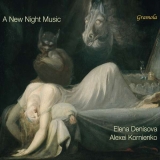Nun, dies ist wirklich ein interessantes Notturno-Programm abseits des gängigen Repertoires. Es beginnt mit Gian Francesco Malipieros gutgelauntem Canto crepuscolare. Helmut Rogls ‘Ein Traum zur halben Nacht’ ist ein stimmungsvolles Stück, verträumt und gleichzeitig von latenter Unruhe geprägt. Klanglich reizvoll ist Alfred Hubers Incubus, in dem die elektronischen Klänge die Angst der Nacht schüren.
Michael Colinas Notturno ist ein Stück mit einem betont entspannten Lyrismus. Dieter Kaufmanns ‘Durch die Nacht’ für Violine & ‘Prerecorded Elektroacoustics’ op. 219 geht von Mendelssohns Hochzeitsmarsch aus und beschreibt eine recht hektische Reise durch die Nacht, die sich beim Sonnenaufgang in Ruhe verwandelt.
John Cages 1947 aufgeführtes Nocturne für Violine & Klavier hat einen atmosphärischen Charakter und soll, nach des Komponisten Anweisungen « mit anhaltenden Resonanzen und sempre rubato gespielt werden, was dem Werk einen eigentümlich romantischen Charakter verleiht. »
Abschließend erklingt Oscar Jockels All the darkness we can hear – all the silence we can see. Der Komponist hat es mit ‘Fünf klingende Quadrate über das fehlende Menuett aus W. A. Mozarts Eine kleine Nachtmusik’ untertitelt. Und er erklärt das so: « Der Bezug zu W. A. Mozarts Eine kleine Nachtmusik wird – unter anderem – auch auf formaler Ebene deutlich. So umfasst das Stück, wie die ursprüngliche Streicherserenade auch, insgesamt fünf Sätze. Was mich fasziniert, ist die Tatsache, dass wir lediglich vier Sätze der fünfsätzigen Kleinen Nachtmusik kennen, da ein Menuett-Satz verschollen ist. Fast scheint es so, als sei das fehlende Menuett, die unbekannte Abwesenheit, das Epizentrum der bekannten Nachtmusik: Vielleicht ist die Serenade gerade durch eben dieses Fehlen, durch diese Abwesenheit ein zeitloses Stück geworden? Natürlich ist das eine Überspitzung, zumal vielen nur der erste Satz geläufig ist. Dennoch sehe ich das fehlende Menuett als essentiellen Bestandteil der klar strukturierten Streicherserenade an, weshalb ich mich entschieden habe, gleichsam fünf leere Quadrate als hörbar gemachte Zeit zu durchleuchten. »
Elena Denisova und Alexei Kornienko achten sowohl auf den großen Bogen und die Stimmungen als auf das jeweils momentan Ereignishafte der Musik. So entsteht auch eine große Spannung im musikalischen Ablauf, der als eine lange musikalische Erzählung aufgefasst wird.
Alle Stücke sind vom Feuer der Kommunikation gezeichnet und bringen intensiv und beseelt gespielte Musik zu Gehör.
Well, this is really an interesting nocturne program away from the usual repertoire.It begins with Gian Francesco Malipiero’s good-humored Canto crepuscolare. Helmut Rogl’s ‘Ein Traum zur halben Nacht’ is an atmospheric piece, dreamy and at the same time marked by latent restlessness. Alfred Huber’s Incubus is sonically enjoyable, with electronic sounds stirring up the fear of the night.
Michael Colina’s Notturno is a piece with an emphatically relaxed lyricism.Dieter Kaufmann’s ‘Durch die Nacht’ for violin & ‘Prerecorded Elektroacoustics’ Op. 219 takes Mendelssohn’s Wedding March as its point of departure, describing a rather hectic journey through the night that turns to tranquility as the sun rises.
John Cage’s Nocturne for Violin & Piano, performed in 1947, is atmospheric in character and, according to the composer’s instructions, « should be played with sustained resonances and sempre rubato, giving the work a quirkily Romantic feel. »
Finally, Oscar Jockel’s All the darkness we can hear – all the silence we can see is heard. The composer subtitled it ‘Five Sounding Squares on the Missing Minuet from W. A. Mozart’s Eine kleine Nachtmusik.’ And he explains it this way: « The reference to W. A. Mozart’s « Eine kleine Nachtmusik » is also clear on a formal level. For example, the piece comprises a total of 5 different movements, just like the original string serenade. What fascinates me is the fact that we only know 4 movements of the five-movement « Eine kleine Nachtmusik », since a minuet movement has been lost. It almost seems that the missing minuet, the unknown absence, is the epicentre of the well-known « Nachtmusik »: perhaps it is precisely this disappearance, this absence, that has made the Serenade a timeless piece? Of course, this is an exaggeration, especially since many people are only familiar with the first movement. Nevertheless, I see the missing minuet as an essential component of the well-known serenade, which is why I have decided to illuminate 5 empty squares, as it were, as time made audible. »
Elena Denisova and Alexei Kornienko pay attention to both the grand arc and moods of the music as well as to what is momentarily eventful. This also creates a great tension in the musical flow, which is conceived as one long musical narrative.
All pieces are marked by the fire of communication and bring intensely and soulfully played music to the ear.






















